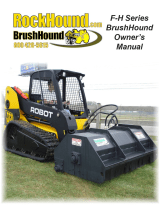
ATTACHING TO THE KX080
ATTENTION
The K4080 brush mower is designed specifically for the Kubota KX080 excavator
and should not be used on any other machine. Make sure the person who is attach-
ing this brush mower has knowledge of attaching regular buckets and can do so in
a safe manner. The method used most often for attaching this brush mower is the
“curl-in” method.
Note: Remember to allow at least 3-5 minutes for the excavator to warm-up before
using with any oil-operated functions or attachments.
• Move the KX080 into position behind the brush
mower. Keep in mind that the “back” of the
mower is the end with the hydraulic motor.
• Once the power unit is in position, lower the ex-
cavator arm into position, inserting the rear por-
tion of the mount into the Quick-Attach (1) first
and then “curling” the front portion down into
place. Insert factory pin (2) to keep brush mower
locked in place. Refer to photo on left.
• Extend the main excavator dipper to its full length
in front of the excavator and set mower down with
the skid shoes firmly on level ground. This will
allow for easy access to the (3) flat-face couplers.
Never stand on attachment to reach couplers.
Turn off the excavator and bleed down pressure
on both high and low flow hydraulic circuits. See
Kubota KX080 Operators Manual.
• Couple the hoses. The female end on the
shredder is pressure in (left side) and the male
end is return (right side). These hoses should be
coupled to the high-flow circuit (26.4 GPM) oper-
ated by the right-hand joystick in the excavator.
Then enable hydraulic breaker mode on the ex-
cavator, allowing for zero pressure return, (4) by
turning the valve located near the hydraulic reser-
voir to the return to tank position. This step is
vital and if not followed will result in damage
to the hydraulic motor. Also, the high flow
circuit is most often the closest to the cab of
the excavator as shown in the second photo.
• If equipped with a thumb, plumb to the low-
flow circuit (17 GPM), which is operated by
the left-hand joystick on the excavator.
Zero Pressure Return Valve To Breaker
Mode “clockwise”.
ATTACHING TO THE EXCAVATOR 5
1
2
3
4
View from
operators seat.
return
pressure
LowFlow (SP2)
outside line
HighFlow (SP1)
inside line























